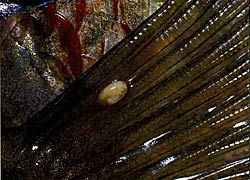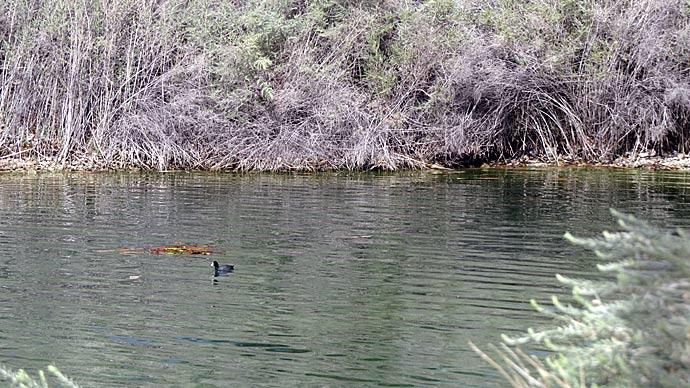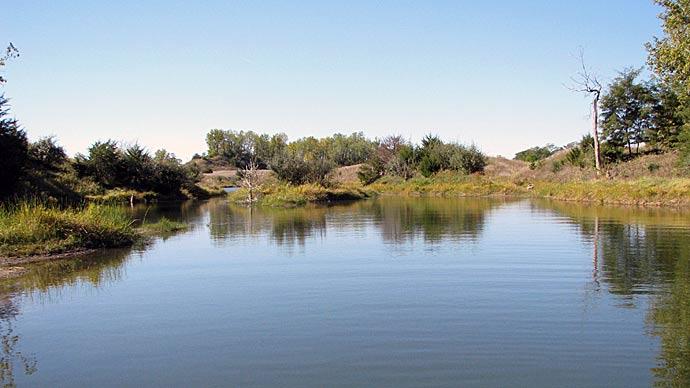The spinnerbait hits a perfect spot. Count to three...retrieve. The blades spin, you can feel resistance. Smooth retrieve, cutting through the water toward rod tip. Suddenly, momentum shifts, the spinner is violently jerked sideways. Fish on! After a quick tussle, a two pound bass makes its way boat side. You lip it, pick up the glistening creature, weary from its fight. What's that, at the base of the bass' tail? It looks like a yellow cyst. A closer examination shows several near the tail, then others at the base of other fins. Parasites?
Most anglers encounter fish parasites at least once. Fisheries biologists obligingly answer plenty questions about these unique organisms. Although the thought of fish parasites may be aesthetically repulsive, these little critters are generally harmless to humans. In fact, parasites which affect most freshwater sportfishes are not at all infectious to humans. Even if you aren't easily convinced, rest assured as long as your fish are properly cooked, there's no way for you to acquire an infection.
Fish parasites come in a variety of sizes and shapes. Some species are flat (flatworms) or tubular (roundworms). Some (thorny-headed worms) have distinct structures that allow them to attach to a fish's intestine. Some fish parasites are found within the body (endoparasites), and some attach to the outer body (ectoparasites).
Some fish parasites are picky about types of fish chosen as hosts. Others are found in a wide range of fish hosts. Some parasite species are restricted to specific geographical regions, while other species are broadly distributed. These creatures are an important part of biology of lakes, ponds and streams, and all naturalists should be aware.
Parasitic infections are normal among fish populations, and some fish may die as a result. It's just one of many ways Mother Nature helps keep population levels in check. That said, severe losses of fish due to parasitic infections are rare.
The actual causes of fish deaths from parasites aren't always obvious. A large percentage of mortality is either caused by physical damage to tissues and organs, by parasites continually "robbing" fish of critical nutrients, or by secondary bacterial and/or fungal infections due to stress from parasite infestation. Parasites can also function as vectors (carriers) of viral diseases.
That's not the worst of it! Many parasites require several hosts in order to complete their life cycles and become reproductively mature. For example, a parasite may be living inside a fish today, but the parasite must somehow get inside a fish-eating bird to complete its life cycle. In order to increase the chances of a bird eating a host fish, some parasites actually alter fish behavior, causing it to swim awkwardly and nearer the surface, where a bird will more likely grab it.
Most parasites a fish harbors will never be seen by an angler. For example, protozoans (single-celled organisms) may live on the gills and fins of a fish, but you won't see them without the aid of a microscope. Some parasitic worms are also microscopic and not likely to be seen. The larger parasitic worms often live within the internal organs, so you'll probably never see them, either. Instead, let's focus on life cycles of some of the parasites that anglers are most likely to encounter.
Trematodes (flukes)

Species in one group of flatworms are often called flukes. Another name for this group is trematode. They are usually short and small, although a few can be seen with the naked eye. You may have noticed small black spots on the outside of fish you were cleaning for your frypan. Or, as you prepared a fillet, you might have noticed yellow worm-like structures embedded in the flesh of the fish. Perhaps you've noticed a fish liver that was covered with small white flecks. These are all stages in the life cycle of different species of flukes or trematodes.
These are not adult parasites. They are immature forms called larvae.
They mature to the adult stage when the fish host they inhabit is eaten by some predator, such as a larger fish, fish-eating bird or carnivorous mammal. They do not mature to adult parasites in humans. If you eat these stages (even raw) they won't hurt you.
The life cycles of the many types (species) of flukes are fairly similar. An adult parasite in a predator animal matures and produces small eggs that pass to the outside of the host. When a microscopic egg reaches a body of water, the small parasite within the egg is either ingested by an aquatic snail or hatches and then finds a snail for a host. One or more additional parasite stages develop within the body of the aquatic snail.
After the parasites develop, they leave the snail and either penetrate the skin of a fish or are eaten by the fish as they swim through the water.
When these larval stages infect a small fish, the parasite larvae can survive as long as the fish does. As the fish gets older, it is exposed to more and more parasites which all co-exist in the fish until a predator eats it. This is why larger fish tend to have larger numbers of parasites.
The "black spot" parasite has the same general life cycle, using snails and fish as intermediate hosts, but after leaving a snail it penetrates the skin and scales of fish and encysts itself in the skin of the fish, appearing as black specks or spots on the fish's skin. When the fish is eaten by a fish-eating bird, such as a kingfisher, the life cycle starts anew.

Another of these parasites is called yellow grub (such as Clinostomum complanatum). You may occasionally see them in the fins or tail of a fish, but you're more likely to encounter the yellowish, worm-like larvae in the flesh of the fish when you fillet your catch. As an adult, the yellow grub lives in the mouth of fish-eating birds, such as great blue herons. The birds pass the eggs through their feces.
White spot flukes (such as Posthodiplostomum minimum) often encyst themselves in the liver, heart or other internal organs of fish. In some cases more than 50 percent of the liver tissue may be taken over by the parasite.
Cestodes (tapeworms)
Tape worms-another type of flat-worm-live as adults in the intestinal tract of fish and as larvae in the body cavity of fish. Sometimes both stages are found in the same fish. Anglers are more likely to notice the forms in the body cavity because they are more visible when cleaning a fish. You'd have to cut into the intestines to see the adults.
The bass tapeworm (Proteocephalus ambloplitis) uses a small aquatic crustacean called a copepod as the first host in its life cycle. Small fish (particularly sunfish and bass) eat a lot of copepods early in their lives, and many of those probably contain the early stages of the tapeworm.
Parasites in the copepod are activated when ingested by the fish. The parasite larvae then penetrate the intestine and move to the body cavity of the fish. Here, they encyst or migrate through various organs. In heavy infections, bass tapeworm larvae can actually destroy gonads and render a fish incapable of reproducing. As smaller fish are eaten by larger fish, the parasites mature to adults in the intestine of the large fish. The tapeworms produce eggs that pass out of the fish and begin a new life cycle.
Nematodes (roundworms)

Round worms are generally long, tubular worms ranging in size from the diameter of thread to the diameter of pencil lead. Several species infect fish, but the most noticeable examples are probably large larval forms that are encysted in the body cavity of fish. These worms mature to the adult stage in a suitable fish, bird, turtle or mammal host. Smaller species normally live within the inside of the intestine. Occasionally they extend from the anus of the fish and can be seen by an angler.
Acanthocephalans (thorny-headed worms)
Acanthocephalan adults live inside the intestines of many species of fish. These worms actually do not have a head, but they do have a holdfast organ (called a proboscis) that has rows of hooks that allow these worms to maintain their position inside the intestinal tract. They probably do not cause substantial harm to their fish host except in extreme densities. Fish become infected by eating the intermediate host (usually an aquatic crustacean like an ostracod or amphipod), or by eating smaller fish that have encysted larval stages.
Crustacea (fish lice and anchor worms)
Ectoparasites are those that can be seen on the outside of the body of a fish. Often, these are a type of crustacean, more similar to crayfish than to any of the other parasites we have mentioned. The fish louse (Argulus spp.), a saucer-shaped animal larger than a fish scale, attacks various fish species. It uses two large sucking disks to hang on to the outside of the fish where it digests blood, mucous and epithelial cells.
Anchor worm (Lernaea spp.), another common crustacean parasite, has two pairs of horns at its anterior end that embed (or "anchor") into the host's flesh. The damage to the host scales and skin can be extensive and is often results in secondary infections caused by bacteria and fungi. Adult anchor worm females appear to have long forked tails, but these are actually mature egg sacs.
Both the fish louse and the anchor worm have free-swimming larval stages that can move from one fish to another. Sometimes larval ectoparasites infect small fish and then move to larger fish as they mature.
Parasitic infections in wild fish in reservoirs, ponds, streams, and rivers are usually self-limiting and cause little concern to fisheries managers. In hatcheries, however, parasitic infections can cause havoc because of high fish densities. Controlling infections in such situations often involves removing support for part of the complex life-cycle of the parasites. For example, it's possible to reduce fish parasites in ponds by removing some of the vegetation that snails require.
Here's the bottom line. Parasites come, they go. Pond managers observe parasites from time to time, but rarely need to take action. When parasites make their way into sportfish, it's not necessarily a problem. But, to lower the incidence of parasites, one (or more) hosts need to be managed or eliminated. The most common practice is to manage excessive aquatic plants, which house snails, or to use red ear sunfish to eat snails. Or, both. Remember, balancing a pond and its life is key to success. Dealing with parasites is also a balancing act.
Midwest Lake Management is a pond/lake consulting business specializing in vegetation control, fish population management, and habitat enhancement for the greater Kansas City area. They can be contacted at 7561 SW Prairie Ridge Road, Polo, MO 64671.816-804-5604
Reprinted with permission from Pond Boss Magazine



